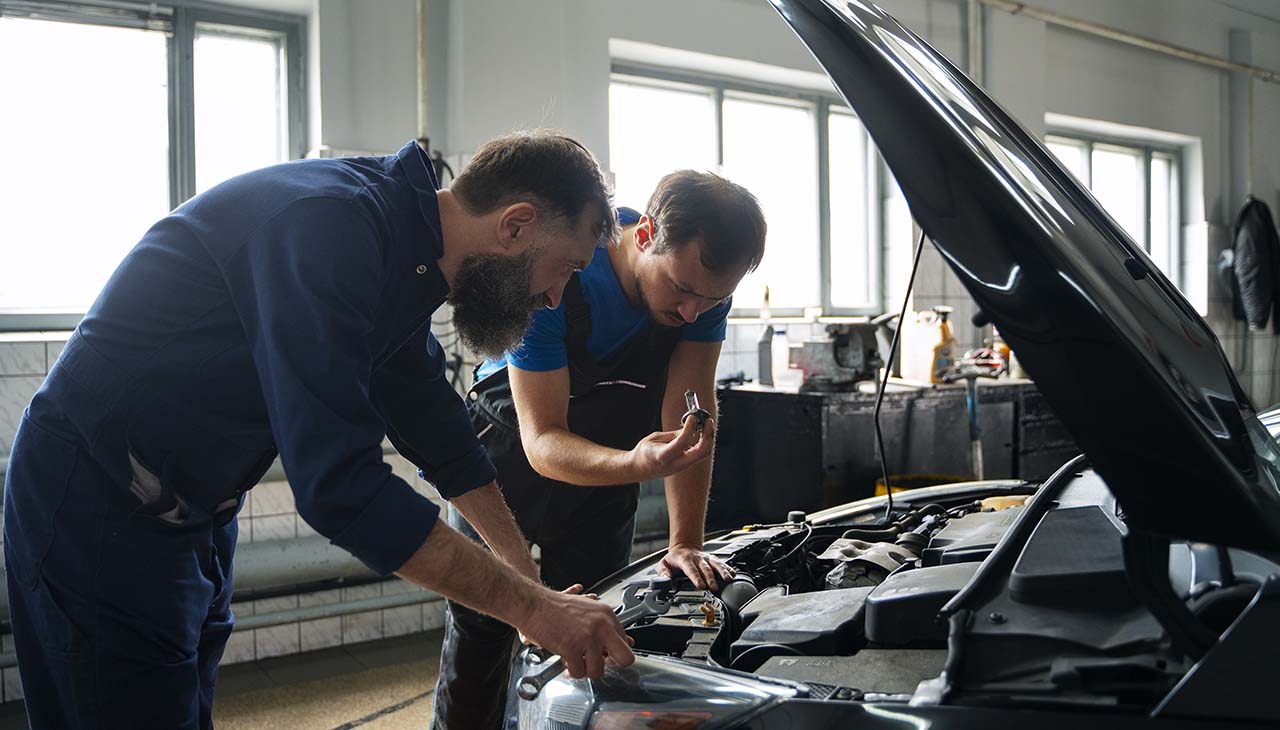Navigating the ins and outs of car maintenance can often feel daunting, especially for those who don’t consider themselves automotive enthusiasts. However, learning basic car troubleshooting techniques is not only empowering but also can save you time, money, and unnecessary stress. This guide is designed to equip you with fundamental knowledge and skills to assess and address common car problems. Whether it’s a strange noise, a warning light, or an unexpected issue, understanding the basics can help you make informed decisions about vehicle maintenance and when to seek professional help.
Check Engine Light
The check engine light on your dashboard is a critical indicator that something is amiss with your vehicle. While it’s easy to ignore, understanding its cause can prevent more severe issues down the road. When this light illuminates, it’s a signal from your car’s onboard diagnostics system that it has detected a problem. Using an OBD-II scanner, which can be connected to your vehicle’s OBD-II port usually found under the dashboard, allows you to retrieve specific error codes related to the malfunction. These codes serve as a starting point for diagnosing issues and determining whether a visit to a mechanic is necessary. Researching the error codes will give you insight into potential problems and their severity, helping you make informed decisions about your car’s maintenance and repair needs.
Fluid Levels
Monitoring and maintaining your vehicle’s fluid levels is paramount to ensuring its smooth operation and longevity. Regular checks of the engine oil, coolant, brake fluid, and transmission fluid will not only keep your car running efficiently but can also prevent costly repairs down the line. It’s essential to top up these fluids as needed, adhering to the vehicle manufacturer’s recommendations for the specific type and amount of each fluid. During these checks, be vigilant for any signs of leaks, as these can be early indicators of more significant problems requiring immediate attention. Routine maintenance of fluid levels can significantly contribute to your car’s overall health and performance.
Battery Maintenance
Your car’s battery is the powerhouse that keeps it running, making its maintenance crucial for your vehicle’s reliability. To ensure your battery is in top condition, start by inspecting it for any signs of corrosion around the terminals, which can interfere with the electrical connection. Corrosion can be cleaned with a battery cleaning brush or a mixture of baking soda and water to prevent further damage. After cleaning, check that the connections are secure and tightened properly to ensure efficient operation.
Testing the battery voltage can further assess its health. Using a multimeter set to the DC voltage setting, you can check if the battery maintains a charge around 12.6 volts when the engine is off, and between 13.7 and 14.7 volts when the engine is running. These readings indicate a healthy charging system. However, if the voltage drops below 12.4 volts when the car is off, it may be time to consider replacing the battery.
The age and general condition of the battery are also important factors to consider. Most car batteries have a lifespan of three to five years. If your battery is approaching or has surpassed this range, it may be wise to replace it even if it’s currently showing no signs of weakness. Regular checks and maintenance can prevent unexpected battery failures and keep your vehicle running smoothly.
Tire Pressure and Tread
Maintaining proper tire pressure is essential for safe driving, optimal fuel efficiency, and extending the lifespan of your tires. Regularly checking the tire pressure ensures that your tires are inflated to the manufacturer’s recommended PSI levels, which can typically be found in the vehicle’s owner manual or on a sticker inside the driver’s door. Underinflated tires can lead to uneven wear, reduced fuel economy, and even blowouts, while overinflation can make for a rough ride and uneven tire wear.
In addition to monitoring tire pressure, inspecting the tread depth is crucial for maintaining good traction on the road. Look for the wear indicators – small raised bars at the base of the tread grooves. If these bars are flush with the tire’s tread, it’s time to replace the tire. Adequate tread depth is essential for effective water displacement and preventing hydroplaning under wet conditions.
Rotating your tires periodically, typically every 5,000 to 7,000 miles, can promote even tire wear. Even wear helps extend the lifespan of your tires and maintain balanced handling of your vehicle. Always refer to your vehicle’s owner manual for specific recommendations on tire rotation patterns and intervals. Regular tire maintenance is a simple yet effective way to ensure your vehicle remains safe and efficient on the roads.
Electrical Systems
The electrical system in your car is a network of circuits and components that power everything from the engine to the headlights. Ensuring these systems are functioning correctly is vital for the safety and efficiency of your vehicle. Start by testing the headlights, taillights, turn signals, and brake lights. This can be done by engaging each light individually while the car is parked and observing them for functionality. It’s helpful to have a partner or use a reflective surface to check these lights if you’re alone.
Another critical aspect to inspect is the car’s fuses. The fuse box is usually located under the dashboard, near the engine, or in the trunk, depending on the vehicle’s model. Check the fuses for any signs of damage, such as melting or discoloration. A blown fuse can cause the electrical components it controls to stop working, which could range from interior lights to the car’s radio. Replacing a damaged fuse is a quick fix but finding the root cause of the fuse blowing is crucial to prevent future electrical problems.
Lastly, ensure that all electrical components inside the vehicle are functioning properly. This includes the dash lights, interior lights, radio, and charging ports. Malfunctions in these areas could be indicative of more significant issues within the car’s electrical system. Regular checks and maintenance of these electrical components can help catch issues early and prevent them from escalating into more severe and costly repairs.
Braking System
The braking system is one of the most critical safety features of your vehicle, requiring regular inspection and maintenance to ensure optimal performance. Listening for unusual noises such as grinding, squeaking, or squealing when braking can be an early warning sign of issues with the brake pads or rotors. It’s crucial to monitor the thickness of the brake pads; pads worn down to less than a quarter of an inch thick need to be replaced to avoid damage to the rotors. The condition of the rotors should also be assessed for any signs of wear or damage, as warped or heavily grooved rotors can compromise braking efficiency and safety. Additionally, the brake lines should be bled periodically to remove any air bubbles. Air in the brake lines can lead to a spongy brake pedal feel and reduced braking force, which can increase stopping distances. Regular checks and maintenance of these components will ensure your braking system functions correctly, providing safe and reliable stopping power.
Suspension and Steering
Maintaining your vehicle’s suspension and steering systems is crucial for safe and comfortable driving. Vibrations or pulling to one side while driving can be indicative of issues within these systems. It’s important to regularly inspect suspension components, such as shocks, struts, and springs for signs of wear or damage. These parts are essential for absorbing road irregularities and providing a smooth ride. Furthermore, ensure the power steering system is functioning correctly by checking the power steering fluid levels. If the fluid is low or has a burnt smell, it may be time to replace it or investigate for leaks. Keeping the suspension and steering systems in good condition not only enhances the driving experience but also ensures the safety of the vehicle’s occupants by maintaining proper handling and stability on the road.

